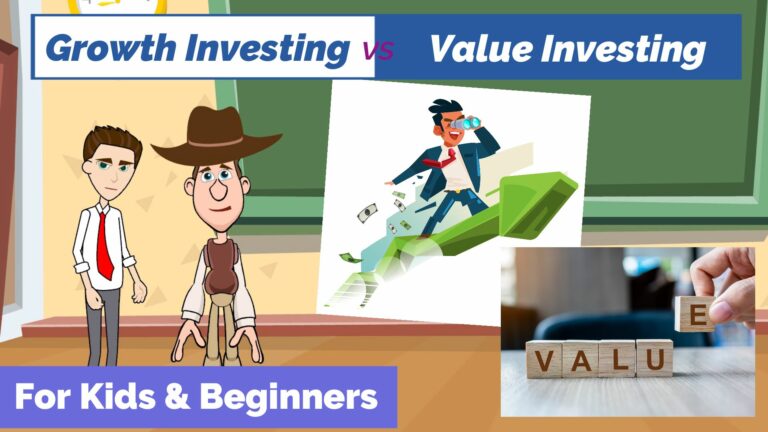Growth vs Value Stocks & Investing for Kids & Teens
This video performs a growth vs value stocks comparison in a simple, concise way for kids and beginners. It could be used by kids & teens to learn about growth vs value investing, or used as a money & personal finance resource by parents and teachers as part of a Financial Literacy course or K-12 curriculum.

Suitable for students from grade levels:
- Elementary School
- Middle School
- High School
The topics covered are:
- Differences between growth stocks and value stocks
- Differences between growth investing and value investing
- Which is better: growth stocks / investing vs value stocks / investing
Growth vs value stocks: What is the difference between growth stocks and value stocks?

Growth stocks are stocks that appear to be overpriced because of their high P/E ratios, but are expected to grow their sales and profits at a much faster rate than the market average.
Whereas Value stocks are stocks that appear to be underpriced based on their P/E ratio and how well the company is doing in terms of sales and earnings.
Are there any other differences?
Growth stocks typically do not pay dividends as they try to reinvest their profits to accelerate their growth, whereas value stocks usually pay consistently good dividends.
Growth stocks are usually either new companies or technology companies like Amazon, Facebook, etc.
Whereas value stocks are usually mature, well-established companies like Berkshire Hathaway, Johnson and Johnson, etc.
Growth vs value investing: How are growth investing and value investing different?
Growth investors only look for stocks that have a high potential for capital growth. But value investors invest in stocks they think are undervalued and are therefore a bargain.
Growth investors may not necessarily focus on the current fundamentals of the company, whereas value investors base their decision on fundamentals like sales and profit, dividend payouts, historic growth, company management etc.
Which is better, growth investing or value investing?

Growth stocks are usually riskier investments, as their sales and profit growth may not live up to the market expectations.
On the other hand, value stocks are less risky, as they are stable companies with a proven track record.
Generally, growth investing is preferable in a bull market, and value investing can be profitable in a bear market.
Download Transcript: Ideal for Use by Teachers in their Lesson Plan to Teach Kids & Teens
Podcast: Growth vs Value Stocks & Investing Comparison
Fun, informative and concise episodes by a 10-year old, breaking down complex financial concepts in a way that kids and beginners can understand. Episodes cover personal finance topics like saving, investing, banking, credit cards, insurance, real estate, mortgage, retirement planning, 401k, stocks, bonds, income tax, and more, and are in the form of a conversation between a cowboy (a finance novice) and his friend, a stock broker. Making finance your friend, only at Easy Peasy Finance.
A little bit about me: I have been fascinated with the world of personal finance since I was 6! I love to read personal finance books, and keep myself updated on the latest by reading various personal finance magazines. My friends often ask me questions about finance because they find it complex and intimidating. That’s what inspired me to start my YouTube channel called Easy Peasy Finance when I was 8, and this podcast 2 years later.
A comprehensive comparison – growth vs value stocks, and growth vs value investing: Differences between growth stocks and value stocks, Differences between growth investing and value investing, Which is better – growth stocks / investing vs value stocks / investing, and more.
Show notes and transcript at: https://www.easypeasyfinance.com/growth-vs-value-stocks-investing-for-kids/


